
Euonymus: planting, pruning, and maintenance
Contents
Burning Bush, in a nutshell
- Euonymus are groundcover or large bushes that offer a multitude of habits and colours
- The evergreen or deciduous foliage presents interesting shapes, variegated with cream, yellow, or even pink, as well as stunning autumn colours in the deciduous varieties
- The fruits provide original decorative interest in certain species, and birds enjoy them in autumn
- Hardy, they adapt to all well-drained soils and tolerate shaded or sunny exposures
- Their uses are varied, ranging from rockeries to hedges, including trimmed borders, topiaries, or small shade trees
- It is the foolproof bush that every beginner gardener will plant in their garden
A word from our expert
Spindle trees form a family of bushes that are highly varied, sometimes deciduous, sometimes evergreen, making them suitable for multiple uses. They are all very easy to establish in well-drained soil and are low-maintenance once they are established.
Discover this wide range of attractive bushes, appealing both for their shape and the colour of their foliage. Evergreen species are appreciated for their variegated foliage, sometimes very fine, ideal for bonsai cultivation. Deciduous species are particularly charming for their autumn foliage and colourful fruits.

Some spindle trees with decorative evergreen foliage: Euonymus fortunei ‘Emerald ‘n Gold’, Euonymus japonicus ‘Pierrolino’, Euonymus japonicus ‘Bravo’, Euonymus fortunei ‘Minimus’, Euonymus fortunei ‘Emerald Gaiety’.
Spindle trees prefer sunny or partially shaded situations and well-drained, rather cool soils. Deciduous species can even tolerate poor soils, regardless of pH. Compact and dwarf bushes adapt well to container planting, while vigorous specimens integrate perfectly into hedges, borders, and even make beautiful standalone features. Some cultivars aim to replace traditional boxwood borders that have been decimated. Pruning of deciduous spindle trees is done in winter, while that of evergreen spindle trees intended for borders, hedges, or topiary is carried out in April and autumn.
Description and Botany
Botanical data
- Latin name Euonymus sp.
- Family Celastraceae
- Common name Spindle
- Flowering depending on the varieties, between May and August
- Height between 40 cm and 5 m
- Exposure Full sun to partial shade
- Soil type fairly cool and drained, rich or poor depending on the species
- Hardiness Very good most of the time
The genus Euonymus, sometimes spelled Evonymus, is more commonly known as spindle. It comprises over 175 species of trees, bushes, and rooting plants (which spread by producing suckers) or even creeping ones. Most grow in the northern hemisphere, with the most remarkable species (Euonymus japonicus, alatus…) found from the Himalayas to the Far East, passing through Southeast Asia. They are also found in North America, Australasia, and Madagascar. However, we have our own European species, the European spindle, Euonymus europaeus, widely distributed from Finland to western Asia Minor, nicknamed the “bishop’s cap” due to the shape of its fruits.

Euonymus europaeus, botanical illustration
The genus Euonymus, belonging to the Celastraceae family, is characterised by simple leaves 5 to 12 cm long, opposite but sometimes alternate, and generally with dentate edges and a short petiole. Among the members of this family is Celastrus, a climbing bush valued for its orange fruits. The shape of the lamina is quite classic, ovate to lanceolate, sometimes acuminate. Spindles are divided into two families with differing uses: evergreen and deciduous species.
The evergreen spindles (Euonymus japonicus, fortunei…) have a leathery, waxy texture and dense foliage, often colourful, appreciated for forming hedges, filling rockeries, or serving as focal points when planted alone.
The deciduous species (Euonymus alatus, europaeus, bungeanus), with ordinary leaves, redeem themselves in autumn by offering stunning colours of purple, scarlet, and orange foliage mixed with those of the fruits.
The brown or green branches are smooth or quadrangular. Sometimes, corky outgrowths adorn the stems, giving a winged appearance like the bark of Euonymus alatus or E. phellomanus.
The flowers, formed of 4 petals, are grouped in cymes at the tips of the year’s shoots and are rather insignificant due to their small size, greenish or yellowish hue, sometimes pink, and the almost complete absence of fragrance. Flowering occurs between May and August depending on the species, once the leafing is complete.
The fruits are, however, remarkable when the Indian pink or red capsule, which usually opens in 4 valves, reveals the 3-4 brightly coloured seeds, ranging from vivid orange to vermilion or coral red. These seeds have a fleshy, oily, highly nutritious covering for birds, called an “aril,” which facilitates seed dispersal through their droppings. They remain attached to the capsule for some time.

The berries of some spindle species are very decorative: Euonymus planipes, Euonymus europaeus, Euonymus phellomanus, Euonymus europaeus.
Asian spindles have already piqued the interest of young naturalist Victor Jacquemont (1801-1832), commissioned by the Museum of Paris for an initial journey to Kashmir and Punjab in 1830. Euonymus japonicus became popular in Europe in the 19th century. It provides hard and robust wood for making spinning wheels but is especially known among artists for its wood transformed into charcoal, which allows sketching without marking the paper (hence the name spindle). Its roots produce a latex similar to “gutta percha,” which is also extracted from other trees in the Sapotaceae family.
The main species and varieties
The spindle trees offer an array of stunning habits. Euonymus fortunei, the best-known and arguably the most popular of all, can extend up to 6 m in length and even climb trees like ivy, aided by its climbing roots. However, its cultivars are usually more compact and rarely exceed 1 m in spread. These are well-suited for pot cultivation or for creating topiaries, although their growth is somewhat faster than that of boxwood.
The Japanese spindle tree (Euonymus japonicus) forms a small evergreen tree with a spreading habit, reaching heights of 3 to 5 m, although its variegated cultivars rarely exceed 1.5 m in all directions. Its deciduous counterpart, the European spindle tree (Euonymus europaeus), also provides ideal shade in a small garden, with a spreading habit of 3 to 5 m in height.
To find out which variety will best suit your garden, check out this article: “Spindle: which variety to choose?
The most popular varieties

Euonymus japonicus Aureus - Japanese Spindle
- Flowering time June to August
- Height at maturity 1,50 m

Euonymus europaeus Red Cascade - European Spindle
- Flowering time May
- Height at maturity 3 m

Euonymus fortunei Emerald n gold - Spindle
- Flowering time June, July
- Height at maturity 60 cm
Our favourite varieties

Euonymus japonicus Microphyllus Aureovariegatus - Japanese Spindle
- Flowering time June to August
- Height at maturity 1,20 m
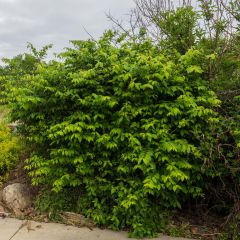
Euonymus alatus Compactus - Winged Spindle
- Flowering time June, July
- Height at maturity 1 m

Euonymus japonicus Bravo - Japanese Spindle
- Flowering time June to August
- Height at maturity 2 m
Discover other Euonymus - Spindle tree
View all →Available in 3 sizes
Available in 3 sizes
Available in 4 sizes
Available in 2 sizes
Available in 2 sizes
Available in 2 sizes
Available in 1 sizes
Available in 2 sizes
Available in 2 sizes
Available in 2 sizes
Planting Euonymus
Where to plant?
Plant your spindle tree in a sheltered and sunny location. However, variegated forms will look better in partial shade and will additionally provide a lovely creamy or golden luminous touch. The entirely green-leaved forms tolerate more shade than the variegated ones.
Deciduous spindle trees (europaeus, alatus, grandiflorus…) are very hardy and can be planted throughout France, except in dry Mediterranean climates.
Among the evergreen forms, fortunei spindle trees can withstand severe cold down to -28°C. In contrast, japonicus spindle trees are more delicate; avoid exposing them to temperatures below -12°C (zone 8 maximum), but they tolerate salt spray perfectly.
Evergreen spindle trees thrive in neutral to chalky soil, which is rather rich and cool, while deciduous spindle trees, indifferent to pH, are content with poor, well-drained soil that is relatively cool in summer. In all cases, avoid waterlogged soils, even though spindle trees appreciate some moisture around their roots. Add a layer of gravel at the bottom of the planting hole if necessary, or plant on a slope to promote drainage.
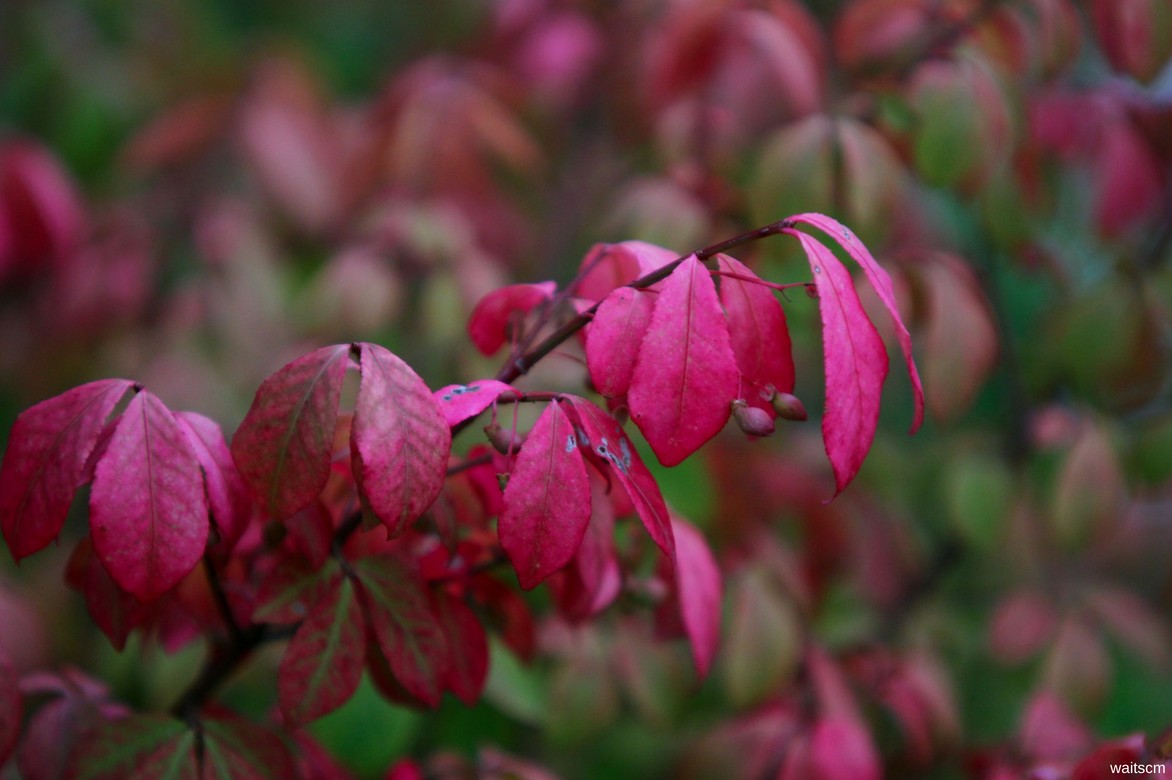
Stunning autumn coloration of Euonymus alatus ‘Compactus’.
When to plant?
Although it is possible to plant spindle trees at any time of the year, it is preferable to do so from October until March or April. Avoid planting during frost or extreme heat.
How to plant?
Allow sufficient space around -1 m² for groundcover species – to enable them to spread harmoniously. In a border or hedge, space the spindle plants 1.5 to 2 m apart from each other and from other trees or bushes, as their dense foliage and significant growth could suffocate them. Dig a trench rather than individual holes to create a hedge.
Spreading climbing species like Euonymus fortunei ‘Minimus’ (15-20 cm high) should be planted 50-80 cm apart to quickly cover the ground with their fine foliage.
To plant:
- Moisten the root ball to aid recovery.
- Dig a planting hole two to three times the size of the root ball. Add a shovelful of well-decomposed compost.
- Place the plant in the planting hole.
- Replace the soil and lightly firm it down.
- Water.
- Spread a layer of mulch around the base to maintain good moisture around the roots. This will also limit weed growth.
For pot cultivation, place a 3-4 cm drainage layer at the bottom of the pot (gravel, broken pottery, etc.). Add a mix composed of 1/3 soil, 1/3 potting compost, and 1/3 coarse sand.

Small evergreen spindle trees are well-suited for container cultivation, here: Euonymus fortunei ‘Emerald Gaiety’, Delphinium ‘Blue Diamonds’, Scaevola ‘White Blessing’.
Read also
Spindle: which variety to choose?Pruning and maintenance
Pruning Euonymus
Prune deciduous euonymus in winter to better assess the shape using pruning shears. Remove poorly placed branches that cross or are damaged. For euonymus trained on a stem, eliminate the low branches coming from the trunk.
Euonymus used for edging or topiary should be pruned with shears or bonsai scissors in April and autumn, or even at the time of planting. This will be more of a pinching than a pruning: shorten the leafy stems by a few centimetres without cutting back to the naked wood. Hedge plants can be pruned with shears or hedge trimmers twice a year, in April and August.
Maintenance
Euonymus are easy to grow trees or bushes that require very little maintenance. Once established, they do not need watering, but it is advisable to water regularly during the first year and subsequently during dry periods. Similarly, if you are growing your euonymus in a pot or container, water 1 to 2 times a week, as the substrate dries out faster than in open ground.
Installing a mulch at the base will help limit the growth of weeds and protect the bush from drought and frost.
Japanese euonymus are the most sensitive to cold. If you are growing these varieties, protect them during the first few years with fleece and by applying a thick layer of mulch on the ground. In case of snow, shake the branches of the evergreen Japanese euonymus to remove it and prevent the branches from breaking under the weight.
Diseases and potential pests
Persistent euonymus are sometimes attacked by mealybugs that form cottony clusters or small dark shields on the stems or beneath the leaves. Treat with white oil or introduce natural predators like the ladybird Cryptolaemus montrouzieri.
Powdery mildew leaves a white dusting on the shoots and leaves of Japanese euonymus, particularly when the first hot weather arrives. Quickly cut away affected parts to prevent spreading. Optionally, apply sulphur to the foliage if symptoms reappear. If your bush is recurrently affected, we recommend relocating it to a sunnier and more ventilated area.
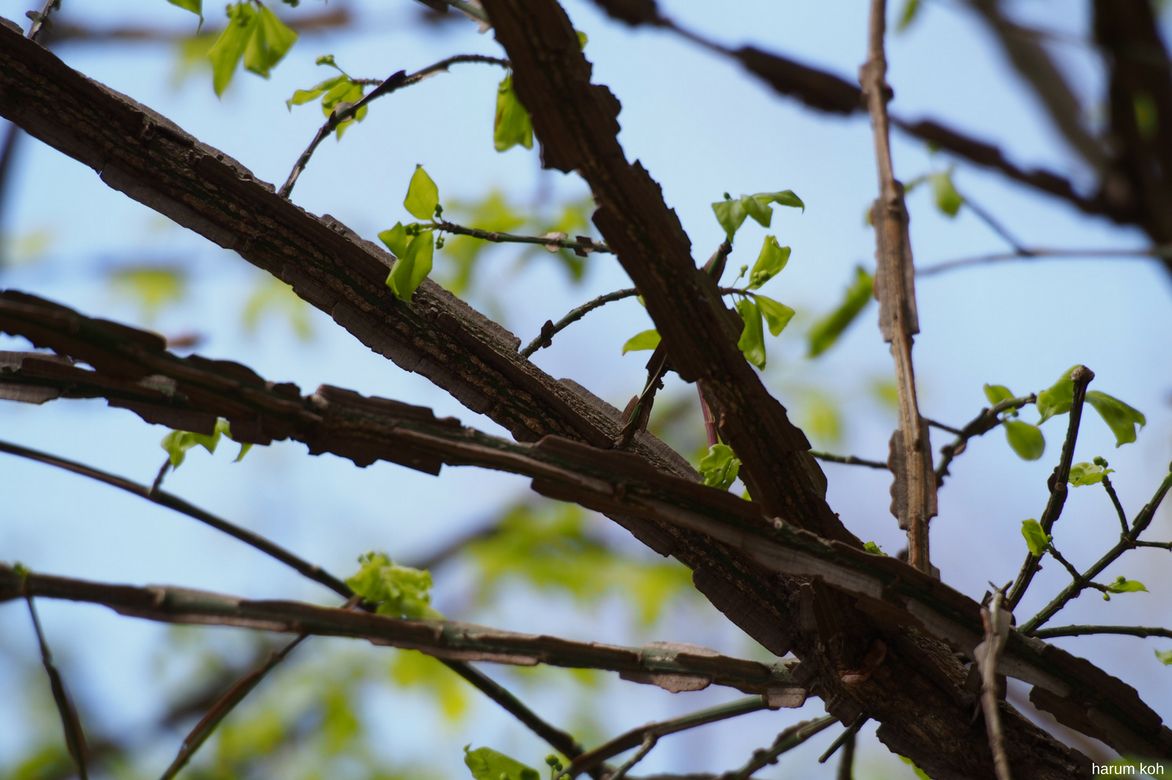
The branches of winged euonymus are very striking, especially in the heart of winter.
Propagating Euonymus: propagation by cuttings and sowing
Euonymus can be propagated by sowing or by propagation by cuttings. Propagation by cuttings is the best technique for evergreen varieties, while sowing is suitable for deciduous ones. It is also possible to divide the clumps of suckering euonymus.
Propagating an Euonymus by Cuttings
Evergreen euonymus can be propagated by cuttings in August using semi-ripe shoots, while for deciduous euonymus, you should wait until September to November with ripe shoots.
- Prepare a pot by filling it with a mix of potting soil and sand, or take your cuttings directly in the ground if it is light, after aerating it with a fork, then moisten the substrate.
- Take a shoot about ten centimetres long from a current year’s growth, ensuring to pull it away at a branching point to obtain a “heel” (the end of the bearing shoot). It should be healthy and free from diseases.
- Remove the leaves near the base of the cutting, and trim the others to reduce the leaf surface. Leave only a few leaves at the top if they have not fallen off.
- Dip the base of the stem in plant hormone.
- Make a hole in the substrate using a pencil or a wooden stick.
- Place the cutting in the hole and gently firm the soil around it to eliminate air pockets and ensure good contact between the potting soil and the cutting.
- Cover the pot with a plastic bag to maintain a humid atmosphere, especially if leaves are present. Ventilate occasionally to prevent the development of fungal diseases.
- Place the pot under a frame in a warm, bright location but out of direct sunlight.
- Transplant rooted cuttings in spring into a richer medium and grow them for at least until the following spring before placing the young plants in their final location.
Sowing Euonymus
Sowing of deciduous euonymus often occurs spontaneously, but you cannot be sure of obtaining the selected variety initially. Use fresh seeds if possible and consider cold stratification (cold treatment in sand) if sowing in spring to break dormancy.
- Harvest the seeds in autumn when the capsules open and remove the brightly coloured aril (fleshy part).
- To stratify the seeds, place them in a tray filled equally with potting soil and sand, or just sand. Moisten the substrate and mix in the seeds. Seal everything in a plastic bag, then place it in a cold environment (between 0 and 5 °C), such as a refrigerator, for two to three months. Sometimes, seeds may germinate while still cold. In this case, take them out as they germinate and transplant them into pots.
- Remove the seeds from the refrigerator.
- Prepare a pot by filling it with a special seed compost.
- Sow the seeds by burying them under 1 cm of soil and place them under a cold frame.
- Water with fine droplets.
Continue to water regularly, but without excess, to keep the substrate moist. Transplant the young seedlings a few months after germination. After one or two years, you can plant them in their final location.
Associating Euonymus in the garden
Spindle trees can create very different scenes depending on the species, as we have seen that their dimensions, habit, and foliage colouration are highly variable. Dwarf or medium-sized evergreen species, whether pruned or not, are used in rock gardens and cottage gardens to replace boxwood, among other uses, and to create topiary art.
Place deciduous spindle trees like Evonymus europaeus ‘Red Cascade’ at the back of a bed of asters and Japanese anemones to enhance the autumn scene, or within a free-standing hedge.
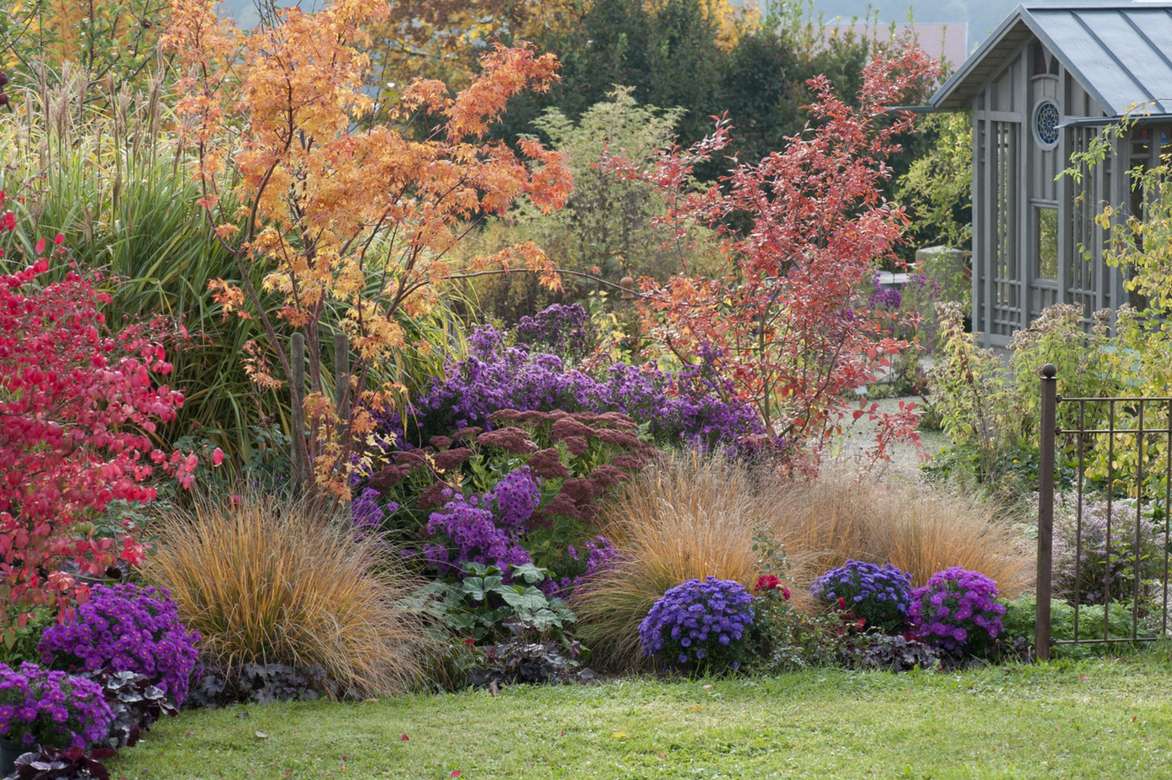
An example of an autumn association: Euonymus alatus, Acer palmatum, Pennisetum alopecuroides ‘Hameln’, Miscanthus sinensis ‘Malepartus’, Sedum ‘Autumn Joy’, Heucheras and various Asters. (Friedrich Strauss – Biosphoto)
Japanese spindle is an ideal partner for creating windbreak hedges by the sea, as it does not thrive in confined spaces or harsh winters.
Creeping spindle like fortunei ‘Emerald Gaiety’ has a rapid growth that allows it to carpet the ground in a bed while brightening it with its olive green and cream tones, which blush in winter. It creates a lovely colourful scene alongside bronze fennel or dwarf roses. It is also original to guide the stems up the trunk of a large tree leaning at about 3 m high or to use it in hanging arrangements, paired with bright pink cyclamen.
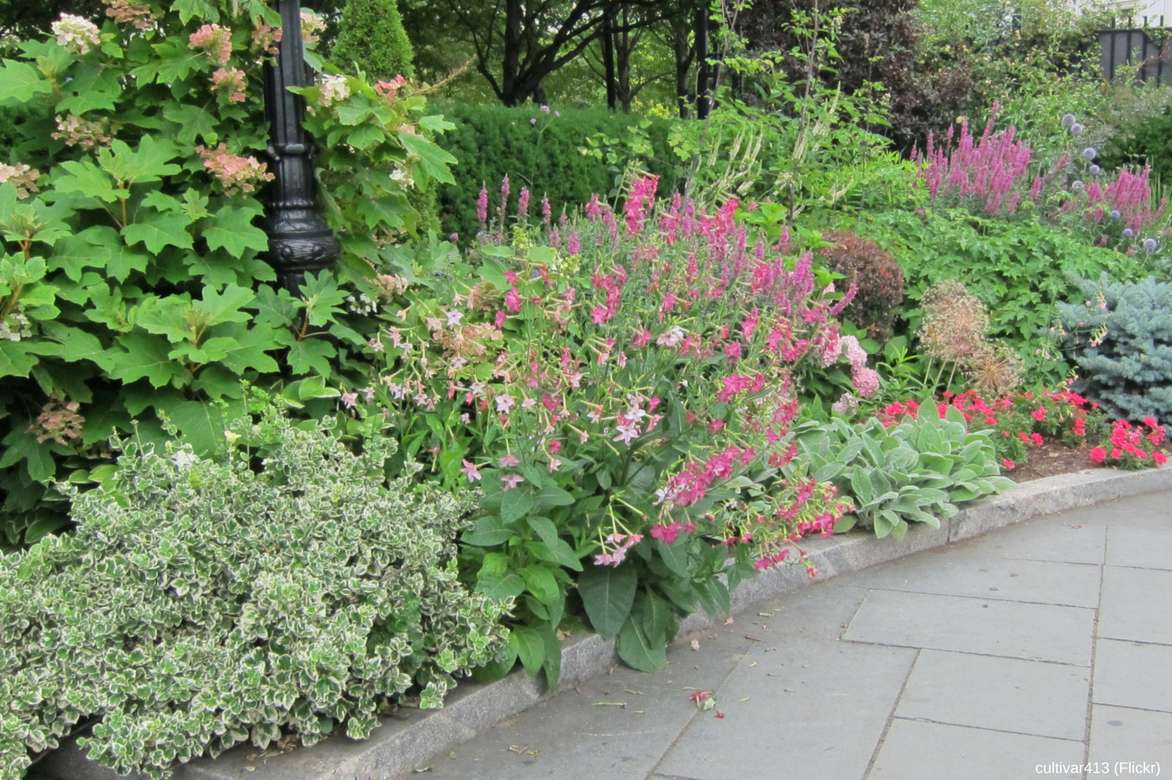
An example of an association: Euonymus fortunei ‘Emerald Gaiety’, Nicotiana alata, Lythrum salicaria, Stachys byzantina, Hydrangea quercifolia ‘Snow Queen’.
For further reading
- Discover our wide range of spindle plants: the most beautiful varieties, deciduous or evergreen
- Find our tips for identifying, preventing, and combating diseases and pests of the Japanese spindle
- Discover our advice on growing an evergreen spindle in a pot
- Our advice sheet: which spindles for a hedge?
- Our advice sheet: which spindles for a colourful winter?
- Our advice sheet: the best groundcover spindles
- Our advice sheets: Japanese spindle, the most beautiful varieties and 5 essential evergreen spindles
- Our advice sheets: The most beautiful colourful spindles in autumn; 7 spindles with exceptional variegated foliage
- Also discover how to train a spindle as a standard?
- Learn more about Euonymus planipes or Euonymus sacchalinensis in Olivier’s video!
- Discover 7 spindles with decorative fruits
Frequently asked questions
-
The leaves of my spindle tree are being eaten by caterpillars in spring. How can I get rid of them?
This is the caterpillar of the spindle moth, a white butterfly with black spots, measuring 2 cm, which lays its eggs on the bark in late summer to autumn. The white caterpillars with black spots, which overwinter in a sort of brownish shield, attack the leaves as soon as the bud burst period begins, producing significant webs and silky nests in the foliage of the European spindle, which they particularly favour. You can cut the infested branches and foliage and burn them to limit the infestation, then apply a preparation based on Bacillus thuringiensis that targets the caterpillars. You can also apply an insecticidal oil to the naked branches during winter to eliminate the eggs and larvae.
- Subscribe!
- Contents
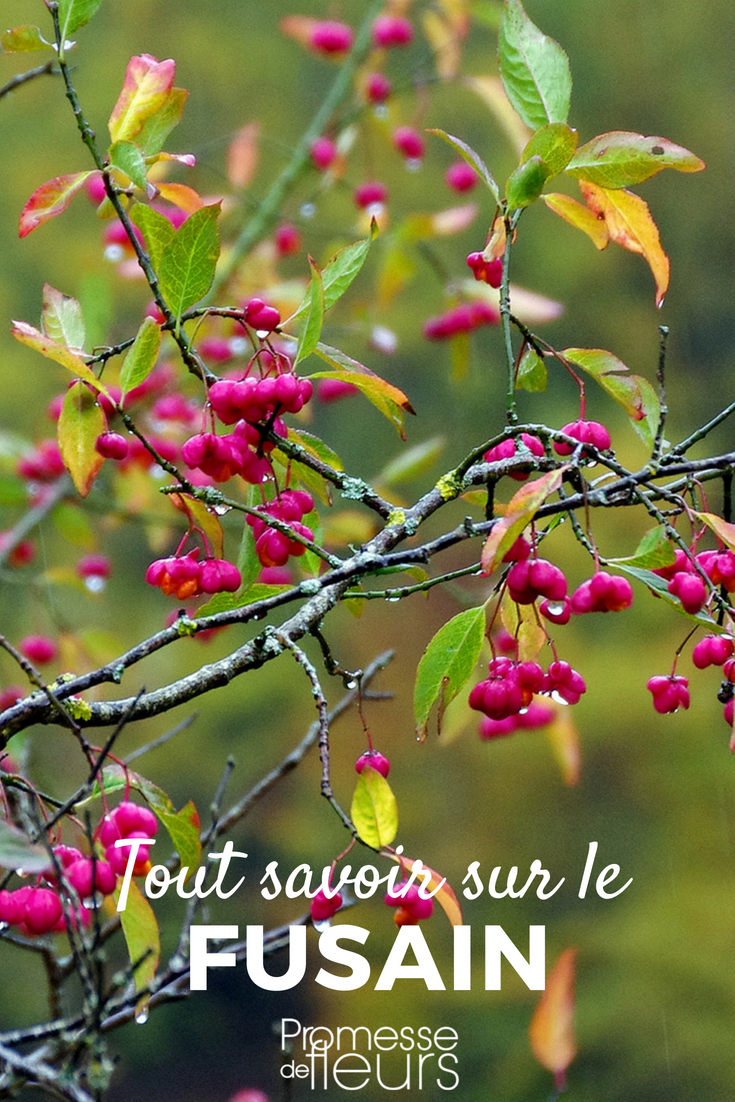
































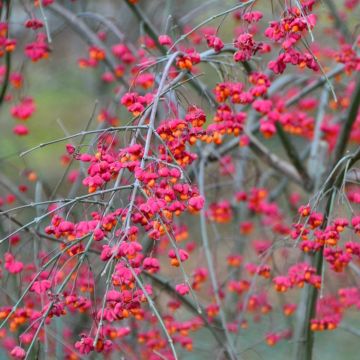



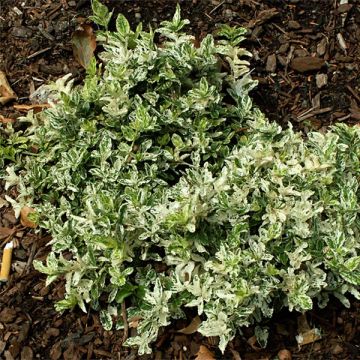
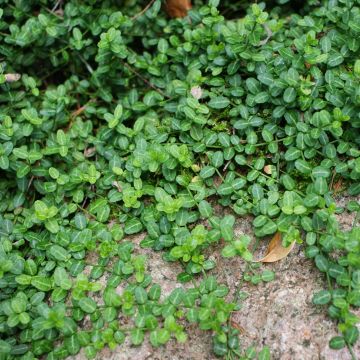



Comments